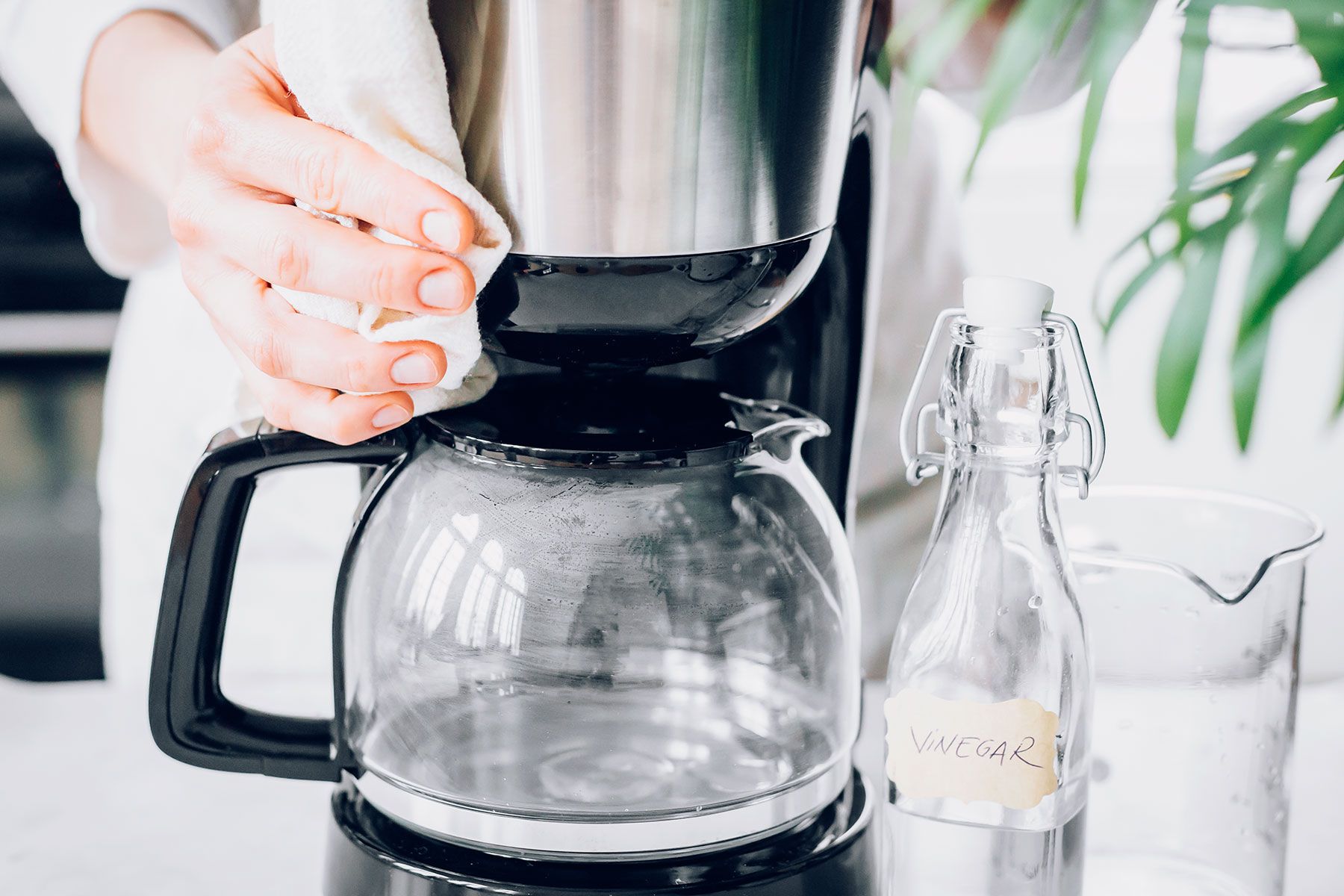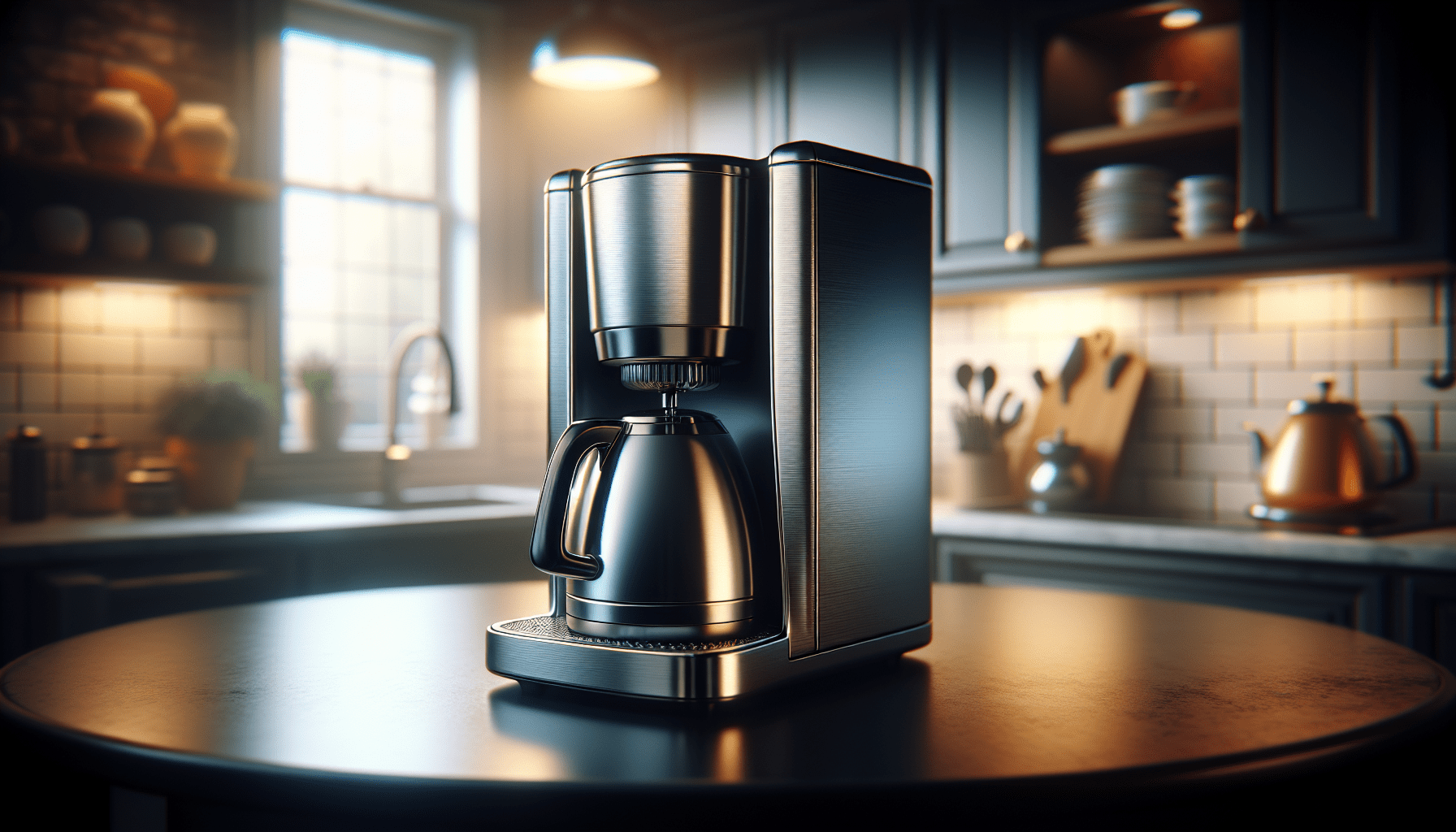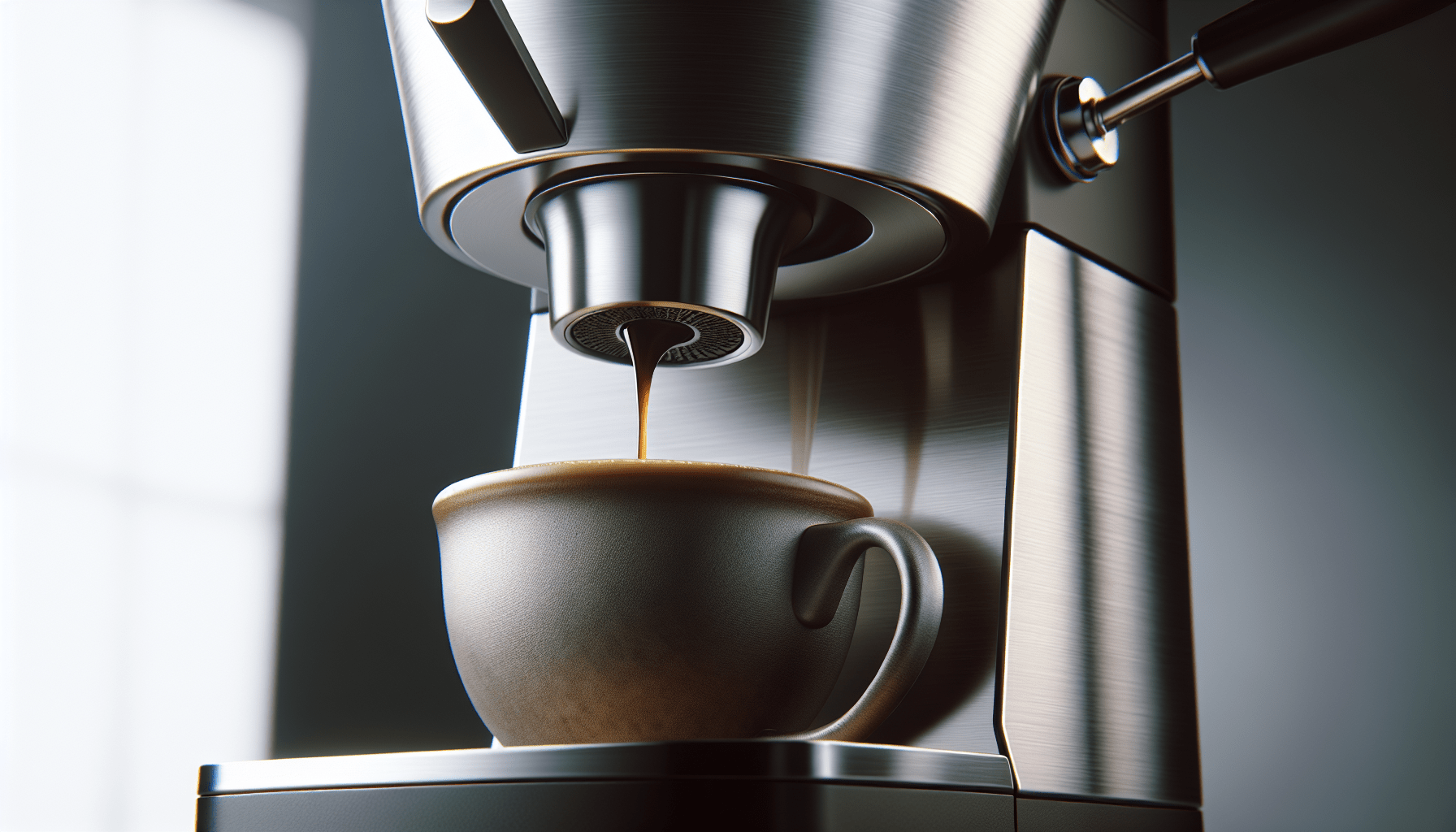If you’re a coffee lover who enjoys brewing your favorite morning joe with a drip coffee maker, you might be wondering just how easy it is to keep this essential appliance clean. Fortunately, keeping your drip coffee maker in pristine condition is a breeze. With a quick and simple cleaning routine, you can ensure that your coffee always tastes fresh and delicious, without any lingering residue or unwanted flavors. In this article, we’ll explore the simplicity of cleaning drip coffee makers and provide some helpful tips to make the process even easier for you. So, let’s dive in and discover just how easy it is to keep your drip coffee maker sparkling clean!
What is a drip coffee maker?
A drip coffee maker is a popular appliance used to brew coffee. It works by pouring hot water over coffee grounds, allowing the water to drip through a filter and into a pot. This method creates a smooth and flavorful cup of coffee, and drip coffee makers are known for their convenience and ease of use.
Definition of drip coffee maker
A drip coffee maker is a countertop appliance that automates the process of brewing coffee. It typically consists of a water reservoir, a heating element, a brew basket, a coffee pot, and various controls for adjusting the brewing process. Drip coffee makers are designed to make brewing coffee simple and efficient.
Components of a drip coffee maker
Understanding the various components of a drip coffee maker is essential for effective cleaning. The key components of a drip coffee maker include:
- Water reservoir: This is where you pour the water to be heated and brewed.
- Heating element: Responsible for heating the water to the desired temperature.
- Brew basket: Holds the coffee grounds during the brewing process.
- Coffee pot: Collects the brewed coffee.
- Filter: Removes impurities from the water and prevents the grounds from entering the coffee pot.
- Controls: Allow you to adjust the brewing time and strength of the coffee.
Why clean a drip coffee maker?
Regular cleaning of your drip coffee maker is crucial for several reasons. Not only does it ensure that your coffee tastes its best, but it also helps maintain the performance and longevity of the machine.
Importance of regular cleaning
Cleaning your drip coffee maker regularly is essential for maintaining the quality of your coffee. Over time, mineral deposits, leftover coffee oils, and mold can accumulate in the machine, which can affect the taste and aroma of your brew. By keeping your coffee maker clean, you ensure that each cup of coffee is fresh and flavorful.
Risks of not cleaning
Neglecting to clean your drip coffee maker can lead to several issues. First and foremost, the accumulation of mineral deposits can clog the machine’s internal components, affecting its functionality and potentially causing it to break down prematurely. Additionally, the presence of mold and bacteria can pose health risks if not properly addressed. Regular cleaning helps prevent these risks and keeps your coffee maker in optimal condition.
Factors influencing how often to clean
The frequency of cleaning your drip coffee maker depends on several factors. It is recommended to clean it thoroughly at least once a month, but some circumstances may require more frequent cleaning. Factors that influence how often you should clean your coffee maker include:
- Frequency of use: If you use your coffee maker daily, it may require more frequent cleaning compared to occasional use.
- Water quality: If your tap water contains high levels of minerals, you may need to clean your coffee maker more often to prevent mineral buildup.
- Environment: Coffee makers kept in high humidity or damp environments may be more prone to mold growth and require more frequent cleaning.
- Manufacturer’s instructions: Always follow the cleaning recommendations provided by the manufacturer to ensure proper maintenance of your specific coffee maker.
Cleaning process for a drip coffee maker
Cleaning a drip coffee maker is a simple process that can be easily done at home with a few basic supplies. By following a step-by-step guide, you can ensure that your coffee maker is clean and ready to brew your perfect cup of coffee.
Necessary supplies for cleaning
To clean your drip coffee maker, you will need the following supplies:
- Dish soap or coffee maker cleaning solution
- White vinegar or citric acid (for descaling)
- Water
- Soft cloth or sponge
- Small brush or toothbrush (for hard-to-reach areas)
Step-by-step guide to cleaning a drip coffee maker
- Start by unplugging your coffee maker and allowing it to cool down.
- Remove any remaining coffee grounds from the brew basket and discard them.
- Empty and rinse the coffee pot thoroughly with warm water.
- Mix a solution of equal parts water and either dish soap or coffee maker cleaning solution.
- Wet a sponge or cloth with the cleaning solution and wipe down the exterior of the coffee maker, including the water reservoir and heating element.
- Fill the water reservoir with a mixture of one part white vinegar or citric acid to two parts water.
- Place a clean filter in the brew basket and run a complete brewing cycle without coffee grounds. This will help remove any mineral deposits and descale the machine.
- Discard the vinegar-water mixture and fill the water reservoir with clean water.
- Run another brewing cycle with clean water to rinse out any remaining vinegar or cleaning solution.
- Once the brewing cycle is complete, rinse the coffee pot, brew basket, and any removable components with warm water.
- Use a small brush or toothbrush to clean any hard-to-reach areas, such as the crevices around the brew basket or the water reservoir opening.
- Dry all components thoroughly before reassembling the coffee maker.
- Plug in the coffee maker and run a brewing cycle with clean water to ensure any traces of cleaning agents are fully removed.
- Your drip coffee maker is now clean and ready to brew delicious coffee!
Cleaning individual components
In addition to the general cleaning process, it is important to pay attention to specific components of your drip coffee maker.
-
Brew basket: Remove the brew basket and rinse it thoroughly after each use. If there are stubborn coffee stains, soak it in a mixture of water and dish soap or vinegar for a few minutes before scrubbing with a brush or sponge.
-
Coffee pot: The coffee pot can develop stains over time. To remove them, fill the pot with a mixture of hot water and dish soap or vinegar. Let it sit for a few hours or overnight, then scrub the stains with a sponge or brush. Rinse thoroughly before using again.
-
Water reservoir: Regularly empty and rinse the water reservoir to prevent the buildup of mineral deposits or mold. Depending on the manufacturer’s instructions, it may also be helpful to periodically soak the reservoir in a vinegar-water solution to remove stubborn mineral deposits.
Tips and tricks for easier cleaning of a drip coffee maker
Keeping your drip coffee maker clean doesn’t have to be a daunting task. By adopting a few preventative measures and following recommended cleaning frequencies, you can make the process easier and more efficient.
Prevention methods to minimize cleaning needs
Taking proactive steps to minimize the need for extensive cleaning can save you time and effort. Here are some prevention methods to consider:
-
Use filtered water: Using filtered water can help reduce mineral buildup in your machine, resulting in less frequent cleaning.
-
Clean the coffee pot immediately: Rinse the coffee pot with warm water immediately after use to prevent dried coffee stains from forming.
-
Regularly replace filters: Replace the coffee filter after each use to prevent clogging and improve the quality of your brew.
-
Empty and dry the coffee pot and brew basket: After each use, empty the coffee pot and remove the brew basket. Allow both to air dry to prevent moisture buildup and mold growth.
Recommended cleaning frequency
The recommended frequency for cleaning your drip coffee maker may vary depending on usage and environmental factors. However, a general guideline is to deep clean your coffee maker once a month. This deep cleaning should include descaling the machine and cleaning all removable components. Regular maintenance, such as rinsing the brew basket and water reservoir, should be done after each use.
Using cleaning solutions or natural alternatives
There are various cleaning solutions available specifically designed for coffee makers. These solutions can be effective in removing mineral deposits and coffee stains. Alternatively, you can use natural alternatives like white vinegar or citric acid. These household items can help descale your coffee maker without the use of harsh chemicals.
When using a cleaning solution or natural alternative, always follow the manufacturer’s instructions and rinse the machine thoroughly afterward to avoid any residue affecting the taste of your coffee.
Special care for specific types of coffee makers
Different types of drip coffee makers may require unique cleaning methods. For example:
-
Thermal carafe coffee makers: These models have a stainless steel carafe instead of a glass pot. To clean the thermal carafe, soak it in a mixture of warm water and dish soap, then scrub with a soft cloth or sponge. Be cautious with abrasive materials, as they may scratch the stainless steel surface.
-
Programmable coffee makers: If your coffee maker has electronic components or a built-in clock, refer to the manufacturer’s instructions for cleaning these specific areas. Generally, a damp cloth or sponge should be sufficient for wiping down the exterior surfaces, while avoiding electrical connections.
Always consult the user manual provided by the manufacturer for any unique cleaning instructions or precautions specific to your coffee maker.
Troubleshooting cleaning issues with a drip coffee maker
While cleaning your drip coffee maker, you may encounter some common issues. Here are a few troubleshooting tips to address these problems:
Removing coffee stains
Coffee stains can be stubborn, but with the right approach, they can be effectively removed. To remove coffee stains from the coffee pot or brew basket:
- Create a paste using baking soda and water.
- Apply the paste to the stained areas and let it sit for a few minutes.
- Scrub the stains with a brush or sponge.
- Rinse thoroughly with warm water.
For stubborn stains, you can repeat the process or use a coffee maker cleaning solution specifically designed to remove stains.
Unclogging the water reservoir or tubes
If your coffee maker is not brewing correctly or the flow of water seems restricted, there may be a clog in the water reservoir or tubes. Here’s how to address the issue:
- Start by unplugging the coffee maker and allowing it to cool.
- Remove the water reservoir and filter basket.
- Use a small brush or toothbrush to gently scrub the inside of the reservoir, removing any debris or mineral deposits.
- Check the tubes or water outlet holes for clogs. If necessary, use a thin, flexible brush to clear any obstructions.
- Rinse the components thoroughly and reassemble the coffee maker.
Dealing with mineral deposits
Mineral deposits can accumulate in your coffee maker over time, affecting its performance. To address mineral deposits:
- Fill the water reservoir with a solution of equal parts white vinegar and water or a commercial descaling solution.
- Run a complete brewing cycle without coffee grounds.
- Discard the vinegar or descaling solution and rinse the water reservoir thoroughly.
- Run two brewing cycles with clean water to remove any traces of vinegar or cleaning solution.
Regular descaling can help prevent mineral buildup and ensure a smooth brewing process.
Replacing worn-out components
If you notice any worn-out or damaged components during the cleaning process, it may be time to replace them. Common components that may require replacement over time include filters, gaskets, and coffee pots. Consult the manufacturer’s guidelines or contact customer support for the appropriate replacement parts.
Maintenance and care beyond cleaning
While regular cleaning is essential, properly maintaining and caring for your drip coffee maker will help extend its lifespan and ensure consistent performance.
Regular descaling to prevent mineral buildup
In addition to regular cleaning, descaling your coffee maker is important to remove mineral deposits that can affect the taste and functionality of the machine. Follow the manufacturer’s recommendations for descaling frequency and methods. Using a descaling solution or white vinegar can help dissolve mineral buildup and keep your coffee maker in optimal condition.
Storage and transportation tips
If you need to store or transport your drip coffee maker, consider the following tips to protect its components:
- Make sure the coffee maker is completely dry before storing or packing it.
- Store it in a cool, dry place to prevent moisture buildup and mold growth.
- When transporting your coffee maker, secure all removable components, such as the coffee pot and brew basket, to prevent damage.
Replacing necessary parts and filters
Regularly checking and replacing necessary parts and filters is important for maintaining the performance of your coffee maker. Ensure you have replacement filters, gaskets, and any other necessary components on hand. Refer to the manufacturer’s guidelines or contact customer support for guidance on when and how to replace these parts.
Comparing ease of cleaning between different drip coffee makers
While all drip coffee makers follow a similar brewing process, the ease of cleaning can vary among different models and brands. Here are some factors to consider when comparing the ease of cleaning between different drip coffee makers:
Factors affecting ease of cleaning
- Removable components: Coffee makers with easily removable and dishwasher-safe components make cleaning more convenient.
- Self-cleaning functions: Some coffee makers have built-in self-cleaning functions, which can simplify the cleaning process.
- Design and accessibility: Coffee makers with well-designed water reservoirs, brew baskets, and filter systems are generally easier to clean.
- Instructions and guidelines: Clear and detailed cleaning instructions provided by the manufacturer can make the cleaning process more straightforward.
Popular drip coffee maker brands known for easy cleaning
Several brands have gained a reputation for producing drip coffee makers that are easy to clean. These brands include:
- Breville: Known for their user-friendly designs and intuitive cleaning processes, Breville coffee makers are often praised for their ease of use.
- Cuisinart: Cuisinart coffee makers typically feature detachable components that are dishwasher-safe, making cleaning a breeze.
- Technivorm Moccamaster: Although known for its premium quality and superior brewing capabilities, Technivorm Moccamaster coffee makers are also designed with cleaning in mind. The removable parts are easy to clean, and the machine itself requires minimal maintenance.
When choosing a drip coffee maker, considering the ease of cleaning as a factor can contribute to a more enjoyable coffee brewing experience.
Safety precautions during cleaning
While cleaning your drip coffee maker, it is important to prioritize safety to prevent any accidents or injuries.
Unplugging and cooling the machine
Before starting the cleaning process, make sure to unplug the coffee maker and allow it to cool down completely. This prevents the risk of electric shock or burns.
Avoiding contact with hot surfaces
When handling various components of the coffee maker, be cautious of hot surfaces, particularly the heating element and the coffee pot shortly after brewing. Use oven mitts or other protective equipment to avoid burns.
Using non-abrasive cleaning tools
When cleaning your coffee maker, use non-abrasive cleaning tools to prevent scratching or damaging the surfaces. Soft cloths, sponges, and gentle brushes are suitable for most cleaning tasks.
Professional cleaning services for drip coffee makers
For those who prefer to leave the cleaning in the hands of professionals, there are services available that specialize in cleaning drip coffee makers. These services offer thorough cleaning and maintenance to ensure your coffee maker is in optimal condition.
Benefits of professional cleaning
Opting for professional cleaning services for your drip coffee maker offers several benefits. Professionals have the expertise and knowledge to thoroughly clean and maintain your machine, ensuring it performs at its best. They can also detect and address any potential issues that may require repairs or parts replacement.
Finding local service providers
To find local service providers that offer professional cleaning services for drip coffee makers, consider the following options:
- Check with the manufacturer: The manufacturer of your coffee maker may offer cleaning services or provide a list of authorized service centers.
- Online directories: Websites or platforms that specialize in home appliance repair and maintenance may have listings for coffee maker cleaning services in your area.
- Recommendations or reviews: Ask friends, family, or coffee enthusiasts for recommendations on reputable service providers who are experienced in cleaning coffee makers.
Conclusion
Drip coffee makers are a convenient and popular choice for brewing coffee at home. With regular cleaning and maintenance, you can ensure that your coffee maker continues to produce delicious cups of coffee.
Regular cleaning is essential to maintain the quality of your brew and extend the longevity of your coffee maker. By following a step-by-step cleaning process, utilizing preventive measures, and adopting recommended cleaning frequencies, you can keep your drip coffee maker in optimal condition.
Remember to prioritize safety during the cleaning process, follow the manufacturer’s instructions, and seek professional cleaning services when needed. By taking proper care of your drip coffee maker, you can enjoy the perfect cup of coffee every time.




